The UIAA’s Summit Series explores a number of the world’s most iconic and challenging mountains and mountain ranges. Produced by the UIAA Medical Commission, they offer information on numerous areas including ascent profiles, acclimatization and preparation. The papers also offer links to live information and introduces other useful areas of UIAA expertise.
About Mount Kosciuszko
Mount Kosciuszko (2228m) is Australia’s highest mountain, located in the Snowy Mountains region of the Australian Alps, which form part of the country’s Great Dividing Range cordillera system. It lies in the state of New South Wales (NSW), near the border with Victoria.
As the highest peak in mainland Australia, Kosciuszko marks an objective for climbers undertaking the traditional list of the Seven Summits (Bass version). Alternative peaks in the region, all higher and more technical, that are included in other list definitions include Puncak Jaya (Carstenz Pyramid) 4884m in Indonesia, Aoraki (Mount Cook) 3724m in New Zealand, and Enduwa Kombuglu (Mount Wilhelm) 4509m in Papua New Guinea.
By comparison to other mountaineering objectives, Kosciuszko itself presents little in the way of a technical challenge, easily accessed by well-marked walking routes in a single day. It does however provide an opportunity to experience and explore the unique elements of the Australian alpine environment. An ancient landscape, it is characterised by vast rolling terrain, small but steep rocky outcrops, and vast views of the surrounding ranges.
Each year the area is accessed by hikers, trail runners, and backcountry winter sport enthusiasts. Visitors must be entirely self-sufficient, as there is limited access to water, little in the way of natural shelter, and changeable weather year round. Several historic huts exist in the park, but are unmanned, and not to be relied upon as accommodation.
The park is home to regionally and nationally significant native plant communities, mainly in alpine and sub-alpine areas, including over 200 species of alpine wildflowers blooming from late spring (October/November) to early summer, ancient snow gums and alpine ash. Above the treeline is exposed heath, grassland and boulder fields. The areas is habitat to many uniquely Australian animals (such as wallabies and wombats) and several nationally endangered animal species including the mountain pygmy possum.
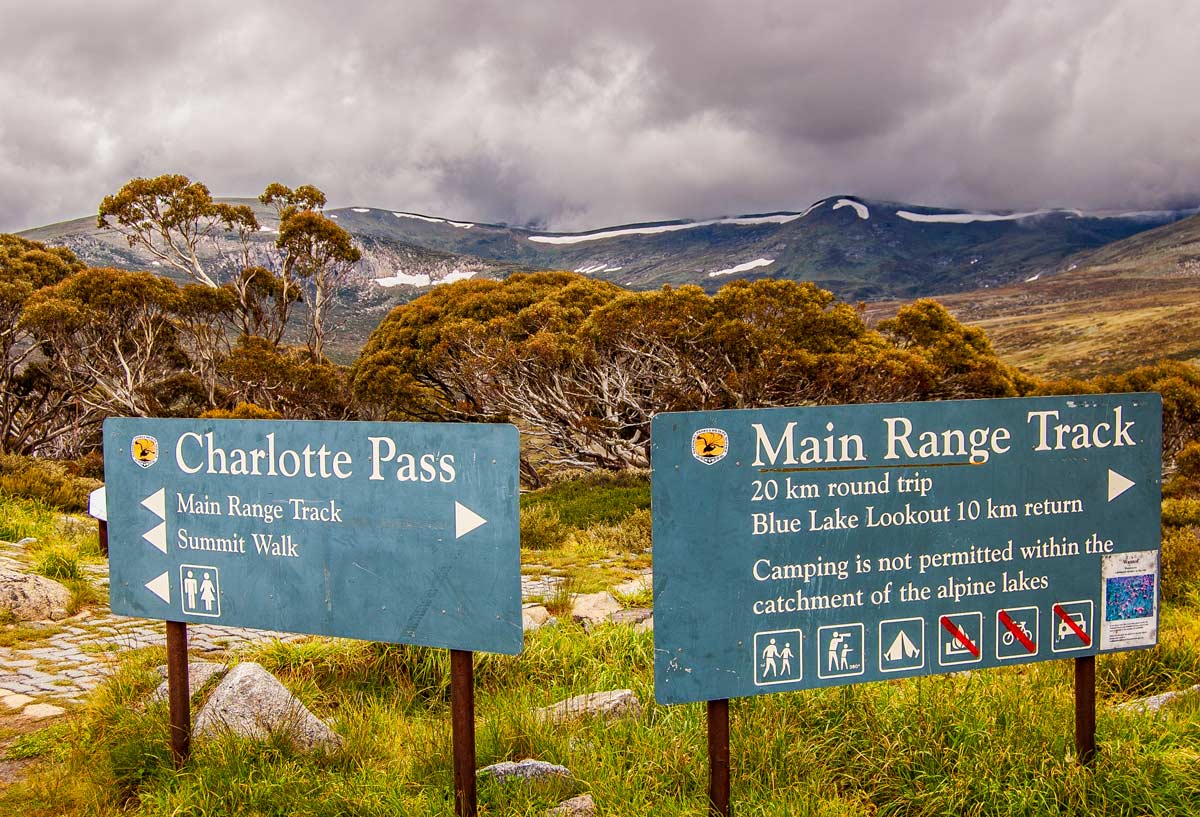
Ascent Profile
Access
The walk up Kosciuszko presents little challenge to experienced climbers. It is a pleasant hike from the Charlotte Pass Road or a slightly harder walk up from Thredbo village. A less travelled, but more interesting approach exists via Hannel’s Spur.
Parties may also choose to extend the trip to take in other surrounding peaks, and there are many fantastic multi day loops/traverses, in all seasons. Consider Mt Townsend, Rams Head, Caruthers Peak, Mt Twynam.
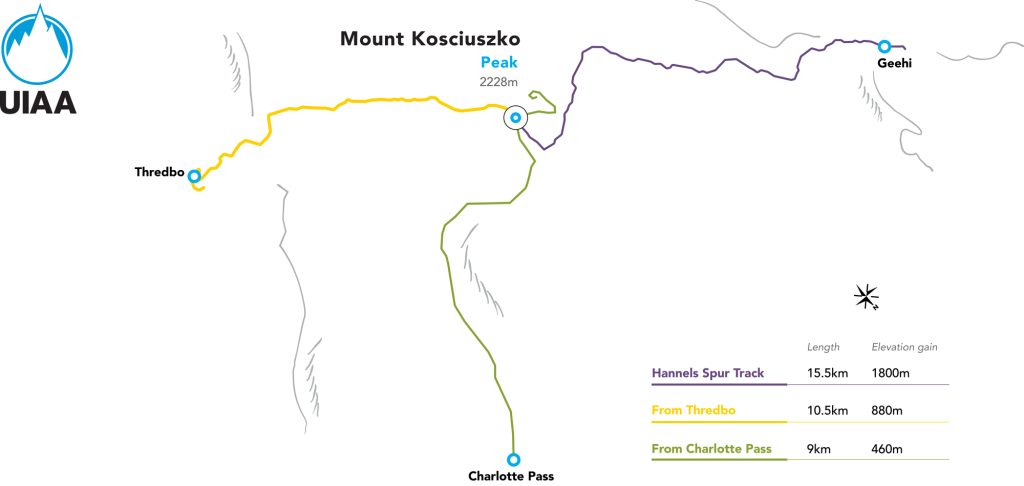
Route Description – From Thredbo
6.5km one way – 2 hours
- Kosciuszko Lookout – 2km
- Rawson Pass – 5km
- Mt Kosciuszko – 6.4km
Begin at the top of the Kosciuszko Express chairlift at Thredbo (15min, cost applies). You can also walk up from the village via Merritts Nature Track which adds 4km and 2 hours uphill. The marked trail runs past Rams Head Range to Kosciuszko lookout, then crosses the headwaters of the Snowy River, climbs to a saddle, and continues to Rawson Pass. It is then a gradual climb along the Summit Walk up to the summit.
Route Description – From Charlotte Pass
9km one-way – 3 hours
- Snowy River – 4.5km
- Rawson Pass – 7.6km
- Mt Kosciuszko – 9km
The trail follows the old road to Mt Kosciuszko. Begin at Charlotte pass, cross the Snowy River the track climb gradually to Rawson Pass. From here, walk to Mt Kosciuszko’s summit.
Route Description – Hannel’s Spur, from Geehi Flats
15.5km one way – 1 to 2 days
- Moiras Flat 6.5km one-way
- Wilkinson’s Creek – 13km
- Mount Kosciuszko – 15.5km
Hannel’s Spur offers the greatest elevation gain in Australia (1800m) and has historically been a training ground for some of Australia’s best mountaineers. Commence at Geehi Flat on the Western side below the range, ascend through a range of vegetation from heavily forested slopes above the Geehi and Swampy Plain Rivers to sub-alpine and alpine tracts on the top of the range. The trail is often overgrown toward the top of the treeline, some navigation may be required. Descent to Thredbo requires planning a car shuttle back to Geehi Flat, there are no existing services.
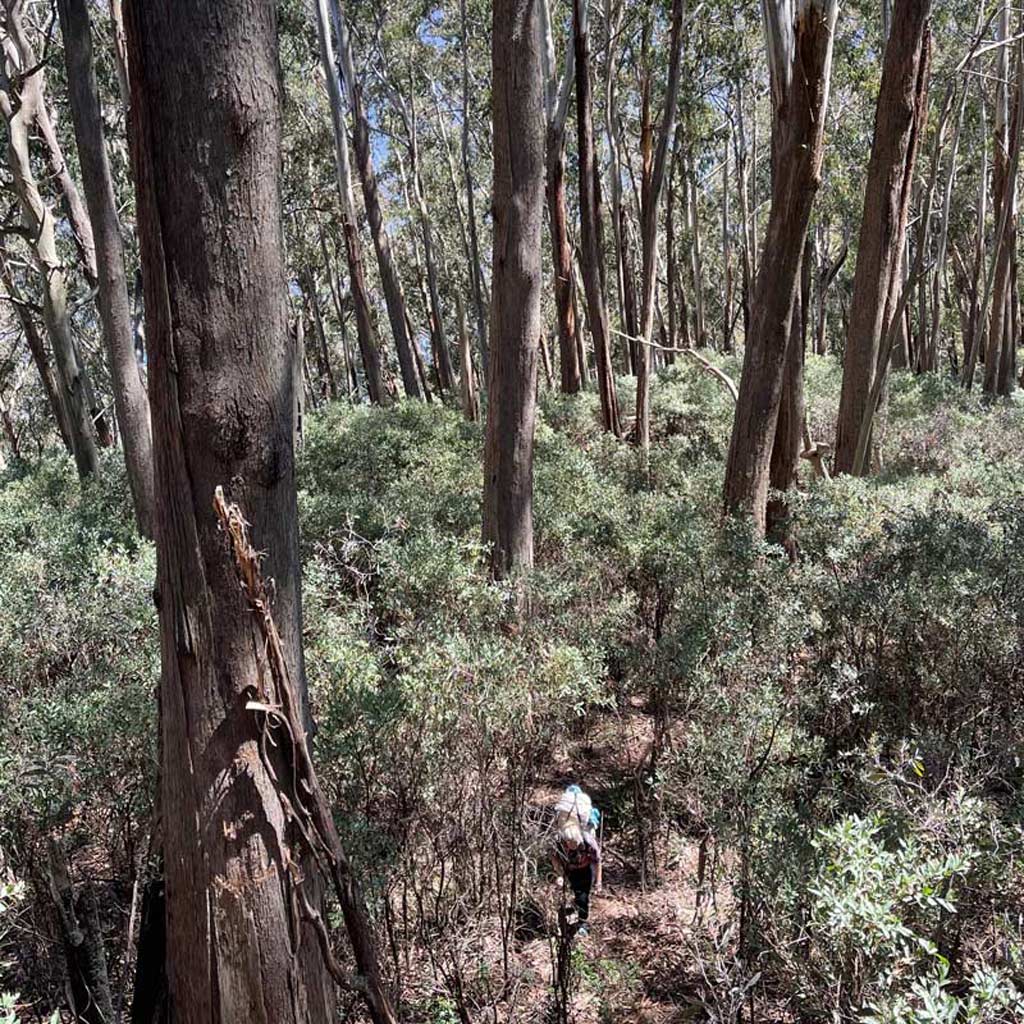
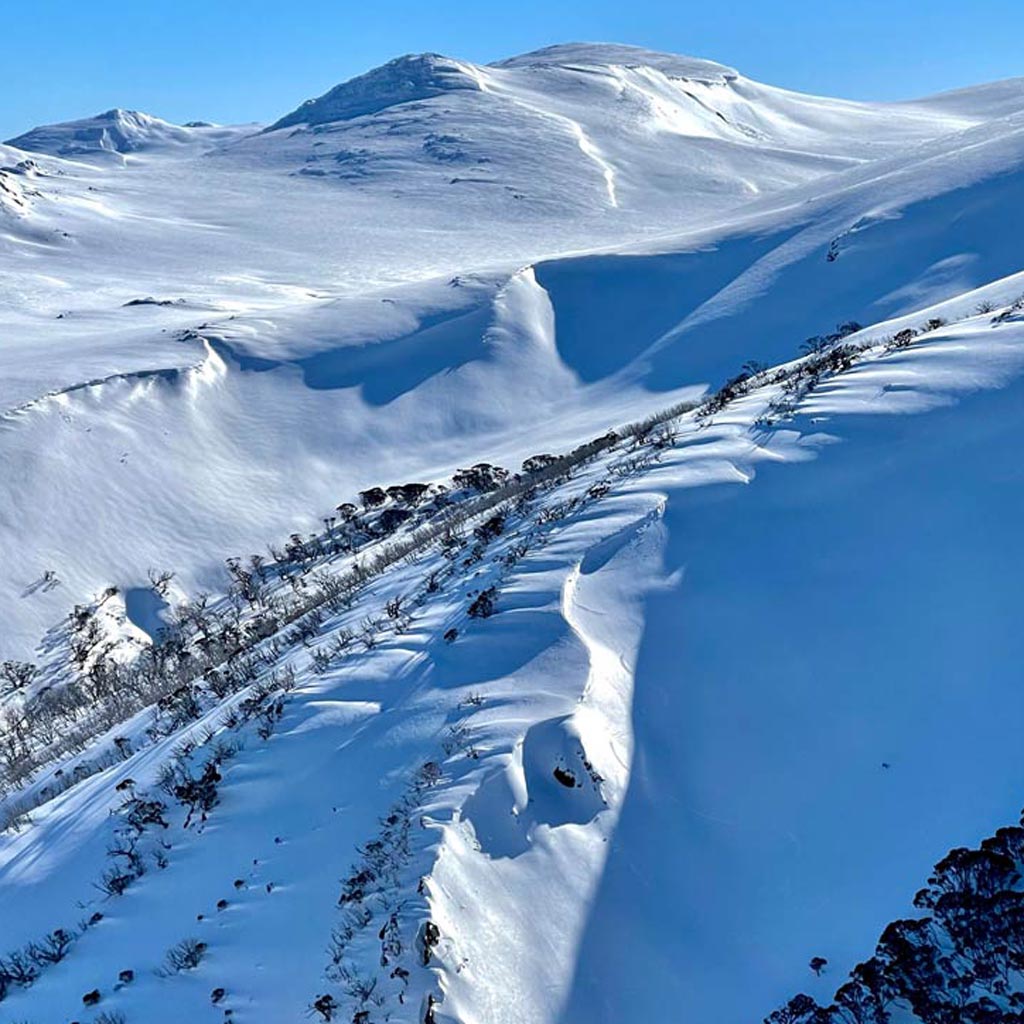
Winter Climbing
There is typically snow on the ground from June to October, although there has been greater variability in recent years due to climate change. The summit can be approached by any of the above routes in winter, but the local ski resort of Thredbo provides a natural access point. Winter activity in the Australian backcountry has exploded in popularity and continues to rise. The vast, low angle terrain provides fantastic opportunities for travel by ski, splitboard, snow shoe, or snow kite. Remote sections of the range provide longer and steeper ski runs. Ice climbing is also possible in a good season (yes – in Australia) at nearby Blue Lake.
The risks of backcountry winter travel remain significant and are not to be underestimated. Changeable weather and variable snow conditions can present challenging conditions even for experienced climbers, and every year multiple unprepared parties are caught out – lost, wet and cold. Complete whiteout is possible even in a good forecast and in many areas there are few natural landmarks. Winds in excess of 100kph rip across the plateau. Solid navigation skills are essential and a means of navigating by GPS is highly recommended.
The major winter alpine hazards are:
- Exposure – the most common issue with conditions that are often wet, windy and around zero degrees. Hypothermia is common in lost and/or underprepared parties. Travel with spare dry clothes and a means of creating shelter.
- Falls – widespread ice and hard wind-stripped snow are common. Despite relatively low angle terrain, slips can be deadly, and furthermore slopes tend to funnel into various terrain traps such as trees and rivers which increase hazard. Standard climbing equipment including an ice axe for self-arrest is recommended.
- Avalanche – there have been deaths in the region. Local knowledge and awareness have improved greatly in recent years, however multiple slides are recorded every season. The most common types we see are wet loose, persistent slab, and cornice fall. Both natural and human triggered occur. Standard safety equipment (minimum beacon/shovel/probe) is required.
The Mountain Safety Collective (MSC) is a non-profit group that provides education, advocacy around backcountry safety in Australia, and importantly issues backcountry condition reports during the winter. They have also installed a free avalanche training centre (ATC) in Thredbo to increase rescue skills.
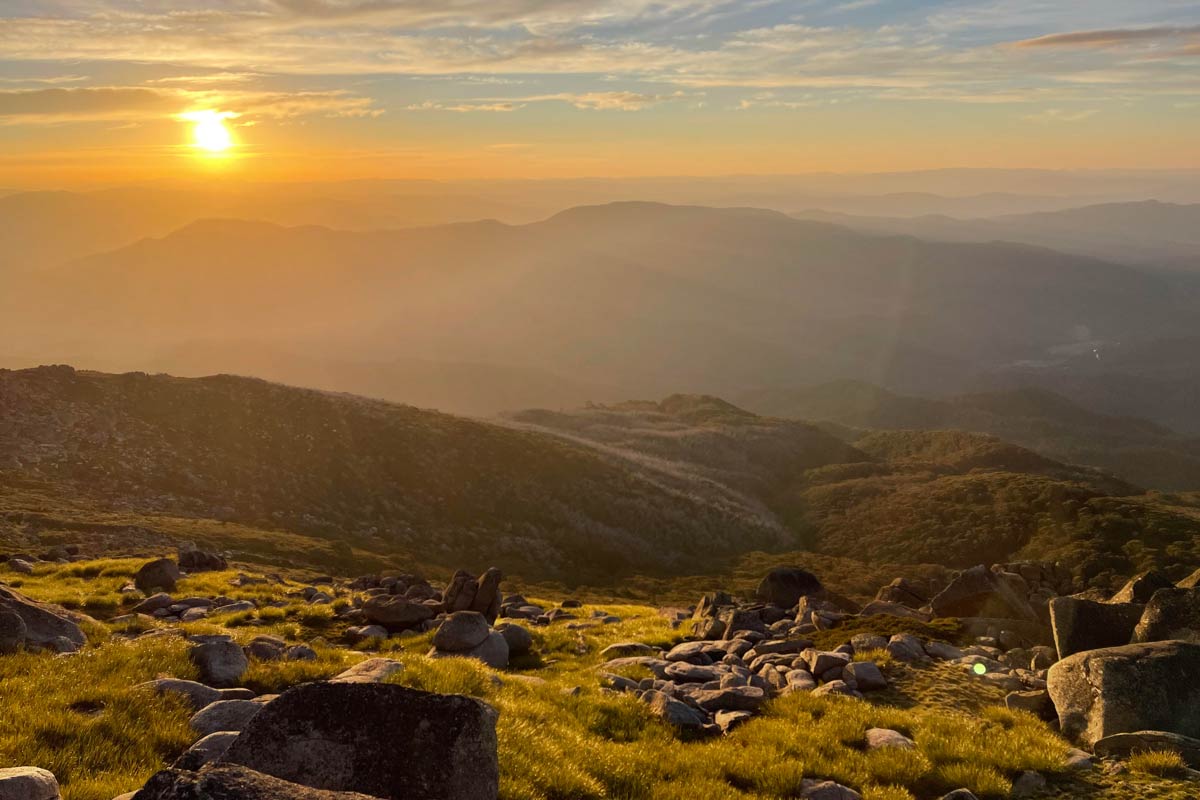
Essentials
Language
English
General Contacts
Snowy Region Visitor Centre
+61 2 6450 5600
Khancoban Visitor Centre
+61 2 6076 9373
Local Currency
Australian Dollar (AUD)
Visa Requirements
Information on entering Australia and visa requirements can be obtained from your country’s Australian embassy, or the Australian Department of Home Affairs.
Nearest Hospital
There are basic medical facilities nearby at Thredbo, Perisher, and Jindabyne. The nearest hospital is located at Cooma, and most major incidents are evacuated to Canberra hospital which has the full range of medical services.
Evacuation
In the event of emergency, dial the local emergency number 000, or activate emergency locating device. Search & rescue in the region is coordinated by NSW Police, with the assistance of the State Emergency Service (SES). Medical evacuation by air is usually undertaken by the Capital Region Retrieval Service to Canberra Hospital.
Climbing Seasons
Kosciuszko can be summited year round. In dry conditions it is a simple hike. Snow cover presents more challenges, usually from June to October, and is often undertaken as a backcountry ski tour.
Communication
Weather is changeable, and often underestimated. In the height of summer temperatures exceed 40 degrees celcius, while in winter may reach below –20 degrees celcius. Most of the range is completely exposed, with little shelter in the event of changes. High winds are frequently encountered. Snow is possible year round.
Technical Difficulty
Not technically difficult, please refer to technical description above.
Environmental Considerations
and Mountain Protection
In recognition of Kosciuszko’s unique value as a conservation area, the park been named a UNESCO Biosphere Reserve. More than half of the area, over 350,000ha, has been declared national wilderness. In recent years the region has been plagued by the effects of climate change, bushfire, an increase in tourism, and growing numbers of feral horses. Drones, commercial filming, pets and smoking are all prohibited in the park. Needless to say there is a leave-no-trace policy for all visitors, and all rubbish and waste must be removed.
The UIAA is committed to the protection of the mountain environment and has been since its founding in 1932. The UIAA Mountain Protection Commission was formed in 1969. Today the UIAA spearheads a number of projects related to sustainability in mountain regions including its annual Mountain Protection Award, through the work of its Climate Change Taskforce and its many international partnerships. For further details please visit: https://theuiaa.org/mountain-protection/
The UIAA encourages all climbers and mountaineers to consider their carbon footprint and adhere to local regulations and customs once on the ground.
Dangers
- Heat exposure (heat stroke, dehydration)
- Bushfire (most recently in 2020)
- Snakes (Eastern Brown, Tiger, Red-Bellied Black, Highland Copperhead)
- Cold exposure (hypothermia)
- Falls (widespread ice)
- Avalanche (wet loose, slab, cornice collapse)
Using Safe
Climbing Equipment
Even a technically straightforward climb like Kosciuszko, requires preparation, training and planning (especially in winter). It also requires having the right equipment. The UIAA encourages all climbers to purchase certified equipment. The UIAA Safety Label is the only global certification for climbing equipment.
The UIAA Safety Label on a piece of climbing equipment means that samples of the equipment have been tested by an accredited, independent third party and shown to satisfy the requirements set forth in the UIAA standard. UIAA standards exist for over 25 times of climbing gear including ice axes, ropes and crampons.
Climbers can search for certified equipment through the UIAA’s dedicated database. Furthermore, the UIAA offers information on how best to purchase climbing equipment.
UIAA Skills Guide
The UIAA is committed to providing climbers and mountaineers with information to develop their skills, whether reinforcing lessons learned and not yet fully assimilated or to increase their technical knowledge and reduce the risks inherent to our sport. The UIAA Alpine Skills Summer guide was first published in 2015. Produced in collaboration with the Petzl Foundation, the guide and has been well received worldwide and is currently available in over ten languages. It covers a host of topics from route planning to frostbite, to reading the weather and climbing in a group. A winter version of the guide will be released shortly. The English language version can be purchased as a digital download here. Foreign language versions are available through UIAA member associations.
Additional UIAA
Medical Resources
MEDICAL ADVICE
Further Reading
Lead Author – Daniel Trevena
Images – courtesy of Stock Libraries and Daniel Trevena
All text and content is reviewed by a dedicated working group within UIAA Medical Commission. Discover more here.

